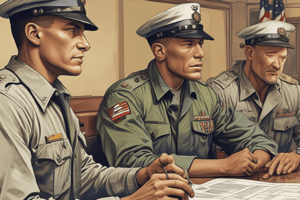Podcast
Questions and Answers
What are the two major categories of planning?
What are the two major categories of planning?
- Operational Planning (correct)
- Force Planning (correct)
- Strategic Planning
- Tactical Planning
What is an Operational Order?
What is an Operational Order?
An order or directive issued by the command to subordinate commanders/Marines for coordinated execution of an operation.
What is a Fragmentary Order?
What is a Fragmentary Order?
An abbreviated order which comes from the original operations order.
What is a Warning Order?
What is a Warning Order?
Define Planning.
Define Planning.
What is the generic planning process?
What is the generic planning process?
Define top-down planning.
Define top-down planning.
Define single-battle concept.
Define single-battle concept.
Define integrated planning.
Define integrated planning.
Define conceptual planning.
Define conceptual planning.
Define functional planning.
Define functional planning.
Define detailed planning.
Define detailed planning.
What are the six steps to the Marine Corps Planning Process?
What are the six steps to the Marine Corps Planning Process?
What is the purpose of problem framing?
What is the purpose of problem framing?
Define design.
Define design.
Define commander's orientation.
Define commander's orientation.
Define task analysis.
Define task analysis.
Identify critical outputs of problem framing.
Identify critical outputs of problem framing.
What is a problem framing brief?
What is a problem framing brief?
Identify the five elements of a Course of Action (COA).
Identify the five elements of a Course of Action (COA).
Define a synchronization matrix.
Define a synchronization matrix.
Identify the commander's wargaming guidance and criteria.
Identify the commander's wargaming guidance and criteria.
Identify critical outputs of COA development.
Identify critical outputs of COA development.
Identify the two types of wargames.
Identify the two types of wargames.
Identify the four methods for conducting wargames.
Identify the four methods for conducting wargames.
Describe the critical roles in conducting a wargame.
Describe the critical roles in conducting a wargame.
Describe the purpose of the Course of Action (COA) wargame brief.
Describe the purpose of the Course of Action (COA) wargame brief.
Describe the different ways a commander can evaluate his course of action.
Describe the different ways a commander can evaluate his course of action.
Define orders development.
Define orders development.
Define transition.
Define transition.
State the purpose of an OPT.
State the purpose of an OPT.
Identify the different roles of the OPT members and their duties.
Identify the different roles of the OPT members and their duties.
Identify the critical considerations for the OPT.
Identify the critical considerations for the OPT.
Flashcards are hidden until you start studying
Study Notes
Marine Corps Planning Process Overview
- Planning is categorized into two major types: Force Planning and Operational Planning.
- Operational orders (OPORD) facilitate coordinated execution of operations, with formal documents outlining directives for subordinate commanders.
Orders in Planning
- Fragmentary Orders provide abbreviated guidance stemming from original OPORDs.
- Warning Orders serve as preliminary notices to prepare subordinates for upcoming operations.
Planning Definition
- Planning involves envisioning a desired future and developing effective strategies to achieve it, as defined by MCDP 5.
Generic Planning Process
- The general steps include assessing the situation, establishing goals, conceptualizing and detailing a course of action, evaluating actions, and issuing orders for implementation.
Types of Planning
- Top-down planning features command-driven processes from initiation to conclusion.
- The single-battle concept considers interdependencies within and outside the operational area.
- Integrated planning ensures coordinated efforts among all units involved.
- Conceptual planning establishes high-level aims and intentions, while functional planning bridges conceptual and detailed planning.
- Detailed planning translates broader concepts into actionable tasks.
Marine Corps Planning Process Steps
- Six critical steps include Problem Framing, Course of Action (COA) Development, Wargaming, COA Comparison, Orders Development, and Transition.
Problem Framing
- Enhances understanding of environmental contexts and problem nature.
- Outputs include intelligence preparation, center of gravity analysis, refinement of estimates, and identification of resource shortfalls.
- Problem framing briefs provide commanders with insights for review and approval.
Course of Action Development
- Successful COAs should be Suitable, Feasible, Acceptable, Distinguishable, and Complete.
- The synchronization matrix illustrates unit activities and interrelations over time.
Wargaming
- Two types exist: Formal and Informal wargaming, employing four methods: Belt, Avenue-in-depth, Box, and Sequence of essential tasks.
- Critical roles in wargaming include facilitator, red and green cell leaders, recorders, and friendly forces.
Evaluation and Development
- COA wargaming briefs outline advantages and disadvantages of each COA, along with suggested modifications.
- Commanders can evaluate COAs based on advantages, disadvantages, and associated risks.
Orders Development and Transition
- Orders development clearly communicates the commander's decisions for execution clarity.
- Transition requires rehearsals and briefs to ensure smooth execution shift from planning.
Operational Planning Teams (OPT)
- The OPT supports commander decision-making by clarifying problems and fostering information sharing.
- Roles within the OPT include Leader, Facilitator, Information Manager, and Recorder.
Critical Considerations
- Key factors for OPT effectiveness include time management, information handling, workspace setup, and briefing guidance.
Studying That Suits You
Use AI to generate personalized quizzes and flashcards to suit your learning preferences.




